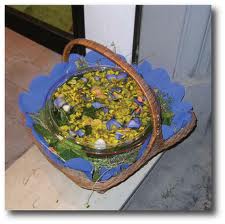Sometimes it is all about the flowers! From the sacred celebration of Corpus Domini
and its Infiorata floral tapestries we move to one of the most romantic and
fragrant rituals of summer, La Notte di San Giovanni, the night St. John’s
Feast. It is magical how intertwined
this Feast Day of St. John, born six months before Jesus, has become with Midsummer’s
Night. The marriage of the sun and moon
in the Summer Solstice comes alive in many different ways from culture to
culture. In Scandinavia huge bonfires
are lit to celebrate the longest day of summer in the land of the Midnight
Sun. People take turns leaping over the
fire to prove their courage. In Italy it
is a little more subdued. The morning of
June 23 we go out into the fields and forests to gather flowers for “Aqua
Odorosa”, Fragrant Water. The golden flowered
summer plants are believed to possess great powers of healing for body
and
soul. St. John’s Wort and Calendula are
the most favored for miraculous healing powers and for girls of a marriageable age
to ensure a happy marriage.
As my friend, Omar, a young stone mason told me
several years ago when I asked about Solstice celebrations, one of his most
treasured memories is of rising early on the day of St. John’s Feast and
going
out into the woods with his beloved grandmother to gather all sorts of flowers
to make St. John’s water, Aqua di San Giovanni.
Here is the recipe: First gather as many of these
flowers and wild herbs that you can find to make enough for everyone in the family:
St. John’s Wort, Calendula, lavender, rose petals, sage, wild mint, chamomile,
laurel and geraniums.
Then immerse them
in bowls of fresh, cold water; enough bowls for each person.
Leave the bowls overnight outside the window
of each sleeping person. St. John will
pass by and bless each bowl to enhance its healing and soothing powers. Rise
early, strain the flowers and bathe your face and hands in this divinely
fragrant water.
I wonder if lupine can be substituted for the golden flowers of Umbria. I’ll let you know!
Read my friend, Roberta's blog to find out more about St. John's Feast and the tradition of "Aqua Odorosa"! She is a great writer at: http://friendsofcama.blogspot.no/







































